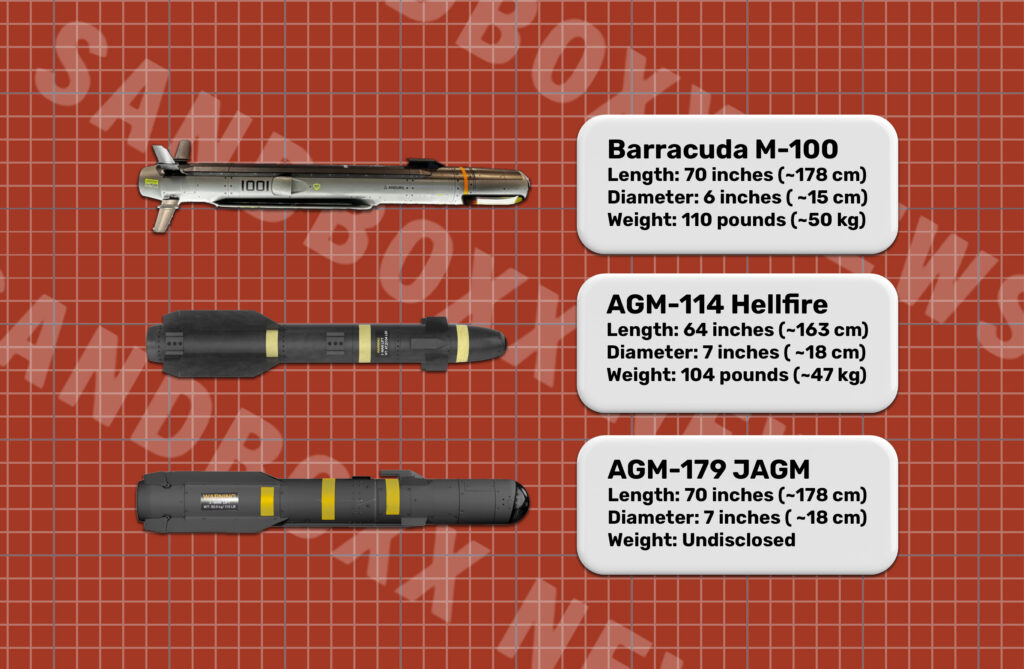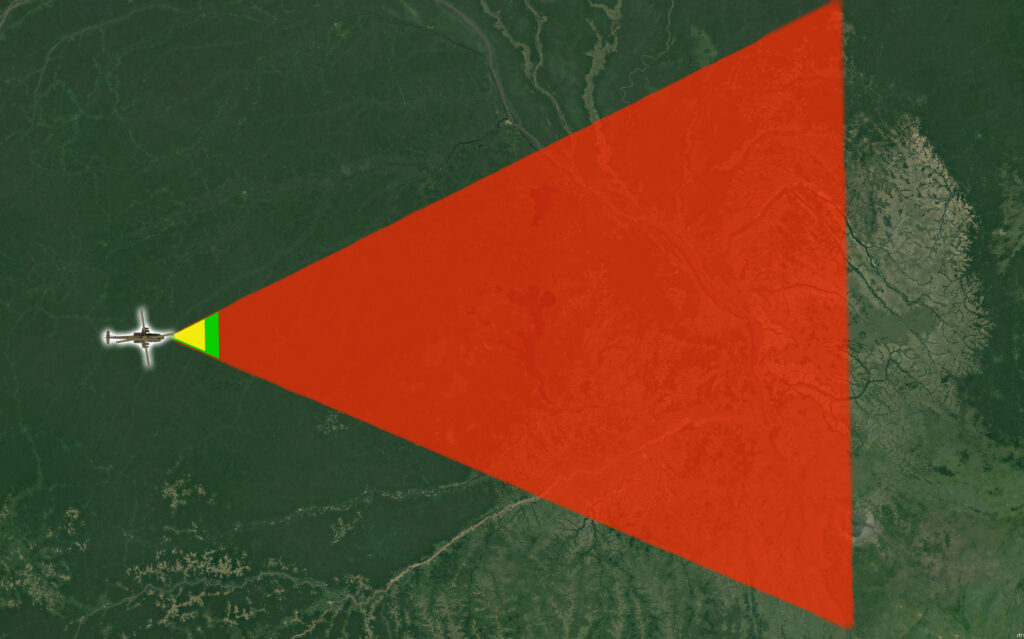A Much Improved Successor To The Hellfire Missile
A Hellfire missile has a similar size (a little over 100 pounds), explosive capacity (20-24 pounds), and range to a 155mm Howitzer round. The guided missile is more accurate, hitting targets within a 10 foot radius about 50% of time, but has a 7 mile range, while the unguided artillery round has a 12 mile range but is much less accurate, hitting targets within a 180-900 foot radius about 50% of the time (which is about 324-8100 times more area than the Hellfire strike zone).
Both pack more punch than the 70 pound shell launched from a 5" naval gun (the largest naval gun in service on any U.S. warship), a 120mm tank shell, a 120mm mortar round, a 105mm tank shell, a 105mm artillery round, a GUB-44/B Viper Strike guided bomb, or any kind of anti-tank missile, rocket, or recoilless rifle round in wide use.
But it is less powerful than a torpedo, a U.S. Army Standard MLRS artillery missile, a Naval Strike missile, and ATACMS missile, a missile launch from a naval vertical launch system (VLS), or any fixed wing aircraft dropped bombs bigger than a Viper Strike.
The Hellfire missile needs only minimal launching apparatus (which allows it to be used from helicopters, light aircraft, drones, and even a slightly modified Humvee), while a howitzer requires a heavy and slow artillery system, about four tons towed, or almost 28 tons for an armored tracked Paladin mobile artillery system (with a peak speed of only about 35 mph, slowing down the force, whose poor fuel efficiency adds to the logistics trail of the force).
The Hellfire missile is much more expensive (around $150,000) than an artillery round (around $2000 with inflation), however. But, the missile's greater accuracy means that far fewer rounds are necessary to reliably destroy the same target, and that it produces far less collateral damage.
As noted in a previous post (emphasis added):
155mm M795 U.S. high explosive howitzer shell (103 pounds) The 155mm (about 6") M777 howitzer, used by the U.S. Marines, has a 90 pound shell, weighs four tons, and has a range of 12 miles with conventional shells and 24 miles with guided shells (Excalibur) which are more accurate as well. Existing Paladin M109 mobile howitzers used by the U.S. Army has a range of about 30 kilometers (18 miles); the design requirement for the existing systems was a target zone of 180 feet radius to about 900 feet depending upon range and other factor; it weighs 27.5 tons (and thus can't be carried in a C-130) and has a maximum speed of 35 mph. The Crusader mobile howitzer, which was cancelled, was going to cost on the order of $24 million or more per one howitzer vehicle. A standard 155mm howitzer shell costs about $1,500 per round.
A proposed next generation successor to the Hellfire missile is similar in size and weight to the existing Hellfire missile, but has twice the amount of explosives (40 pounds) and an 138 mile range with undiminished accuracy, which would hit a tank sized target in Cheyenne, Wyoming (101 miles), Vail (97 miles), or Pueblo (113 miles) from Civic Center Park in Denver.
The main difference between the successor and the existing Hellfire missile is that instead of using a solid fuel rocket, it uses a disposable jet engine. It may actually end up being cheaper than the Hellfire missile when produced in quantity.
California-based Anduril Industries has been scooping up defense contracts left and right in recent years. And now the firm, which is primarily known for its advanced and highly autonomous drone systems, is looking to apply that expertise to precision-guided munitions in a new line of air-breathing cruise missiles they call the Barracuda M.The Barracuda M line is made up of three different weapons: the M-100, M-250, and M-500 cruise missiles. . . . the M-100 significantly outclasses the weapons it could feasibly replace. The M-100 was designed to be carried by rotorcraft like the AH-64 Apache gunship or the AH-1 Cobra, in very much the same way these platforms carry Hellfire missiles today. (Although it could feasibly be launched by any of the long list of other platforms that carry Hellfires.)Indeed, the M-100 is very close in size to the long-serving AGM-114 Hellfire, and even closer in size to the AGM-179 Joint Air to Ground Missile (JAGM) that’s meant to replace the Hellfire.The M-100 is about 70 inches long with a six-inch diameter and weighs roughly 110 pounds. In comparison, the AGM-114 is 64 inches long, with a seven-inch diameter and a total weight of around 104 to 108 pounds; and the new AGM-179, which is 70 inches long with a seven-inch diameter and an undisclosed total weight.
(Graphic by Alex Hollings)But while the M-100 is about the same size as the Hellfire or the JAGM, it packs a much bigger punch.The Hellfire missile carries a roughly 20-pound high explosive warhead and the JAGM is expected to carry about the same. In our original story, Anduril initially told Sandboxx News that their M-100 would carry a 35-pound warhead, but that has since been increased to 40 pounds – twice the size of the Hellfire’s and JAGM’s warhead.The Hellfire missile usually has a maximum range of between four and 6.8 miles, depending on launch conditions – though some variants, like the AGM-114R-4 long-range Hellfire missile that saw testing in 2022, can reach as far as 21 miles. The AGM-179 JAGM, meanwhile, started its journey to service with a stated range of roughly five miles, but has since doubled that figure to 10.
Comparing the maximum ranges of the AGM-114 Hellfire (yellow), the AGM-179 JAGM (green), and the Barracuda M-100 (red). (Graphic by Alex Hollings)The M-100, on the other hand, can carry its 40-pound warhead to targets 138 miles away – or 20 times the Hellfire’s range. This is possible because the weapon carries a completely different type of propulsion system than you’ll find in weapons like the Hellfire which are powered by a solid propellant rocket motor. The M-100 is powered by a very small, air-breathing turbojet engine, the same sort of propulsion system you’d find powering a tactical aircraft or other long-range cruise missiles.The only place the M-100 would fall short of the Hellfire is in maximum speed, as the Hellfire is known to top out at around Mach 1.3, while the M-100 is limited to high subsonic speeds, according to Anduril.Depending on the iteration, Hellfire missiles have a per-unit price of around $150,000, while the newer JAGM costs about $320,000. Although we don’t know how much the M100 will ultimately cost, Anduril focuses on streamlined and simple production. The company says that the entire weapon can be assembled using fewer than 10 simple hand tools, which will make it very easy to train personnel in assembling it. Because of that simplicity, the company claims it can double its production capacity anytime the U.S. needs a surge of precision-guided munitions.This weapon . . . has already seen testing in-house at Anduril and now the company is shopping these weapons to the Department of Defense in hopes of securing a production contract.
In a war like the currently pending Ukraine War, where Russian troops feel secure stationing weapons systems and bases outside artillery range from Ukraine's front lines, widespread availability of these missiles could push back the front lines by 130 miles into Russian territory.
Similarly, this makes it possible to strike at another country (e.g. Israel), or into international waters, from deep inside sovereign territory of the person making the shot.
The larger version of this new missile (the M-250 and M-500) are more comparable to full sized HIMARs, M270, and navy cruise missiles, and to other intermediate range, larger missiles which the Marines, Army, and Air Force are all actively developing.
The greater range also makes real time forward reconnaissance much more important.
A forward observer with a device about the size of a satellite phone, a small reconnaissance drone (ideally with a long range), spy planes, high altitude airships or balloons, or spy satellites, could all provide real time imagery that could direct missiles from distant launch sites to a target.
The Case For A Canon Artillery Substitute Missile
Another possibility would be to develop a missile similar in concept to the M-100, but smaller, with a warhead size similar to a Hellfire missile or 155mm artillery round (20-24 pounds), and perhaps only a fifth as much fuel for a 28 mile range, that is significantly lighter (perhaps 60-75 pounds) than the 90-103 pounds of a 155mm artillery round or the 104-110 pounds of a Hellfire missile or an M-100, as a canon artillery substitute missile.
This canon artillery substitute missile could be fired from a variety of platforms, e.g., a pickup truck mount, a JTLV, a Stryker, an ATV sized ground based drone, an air based drone, a helicopter, a light plane, an AC-130, an A-10, an F-35, a patrol boat, a corvette, or a frigate. Faster, lighter platforms, operating at a greater distance from opposition forces, would be better suited to the modern scoot and shoot tactics of modern artillery forces. Its lighter weight would allow more to be carried on any given platform.
Advanced Energetic Materials
Another way to reduce the weight, without sacrificing explosive power, would be to introduce a new generation (paywalled WSJ article) of "advanced energetic materials - chemicals that propel or explode" which have advanced little since the RDX and Torpex used as TNT replacements which were about 50% more powerful per weight than TNT towards the end of WWII.
For example, an explosive material called CL-20, first identified in 1993 which is currently the subject of research by China and Russia's defense scientists, has been basically stalled in the R&D phase for the last thirty-years, during which it wasn't a priority because counterinsurgency operations in Iraq and Afghanistan were the priority. It is supposed to be 10 times more powerful than TNT (video) making it the most powerful non-nuclear explosive known to man.


No comments:
Post a Comment